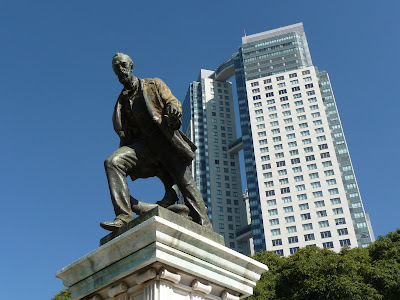Bright, shiny Puerto Madero sits just east of downtown, across a narrow canal. It is the newest of the city's districts, being designated only in 1991. From the 1800s, this area was the working dockland of Buenos Aires. As ships grew every larger, docks that could handle them sprung up to the north of the city, along the actual River Plata coast and this area fell into disrepair, and was even off-limits during the military dictatorship of 1976-1983.
With the return of democracy came the return of real estate speculation, and suddenly Puerto Madero was hot stuff for foreigners with a lot of cash to spread around. Unusually, many of the warehouses in the district were recycled into office and loft housing space, instead of being torn down. Those that were too far gone were however, replaced with shiny tall towers, the largest in town.
The entire area is criss-crossed with spectacular pedestrian promenades, public art, and bridges crossing four basins of water (one of which now houses a very high end yacht club).
This bridge, Puente de la Mujer, is by my favorite contemporary architect, Santiago Calatrava, and it can rotate to allow vessels to pass from the club out into the bay. The suspension and arc of the bridge are said to be inspired by the form of a tango-dancing couple in a lean.
Beyond the spashy architecture and loft spaces (and the most expensive restaurants in town) lies a second component of Madero - the ecological reserve.
Created practically by accident - the zone was used as a landfill during the dictatorship to dispose of massive amounts of earth removed from other parts of the city during public works projects - the idea was to create more land for development. But when the economy tanked during the Falklands war, the plan stalled, and nature took over, with these high grasses and trees taking hold and attracting abundant wildlife and birdlife. Since virtually everyone here lives in apartments, with no yards or outdoor space, this central location within walking distance of downtown is hugely popular on weekends, and especially on days like May Day, the Day of the Worker, with those who aren't interested in attending the huge leftist political rallies in the Plaza de Mayo. It seemed more prudent for me to spend my Saturday among the famillies picnicing along the promenades than getting caught up in anti-foreigner rhetoric downtown.
Subscribe to:
Post Comments (Atom)




No comments:
Post a Comment